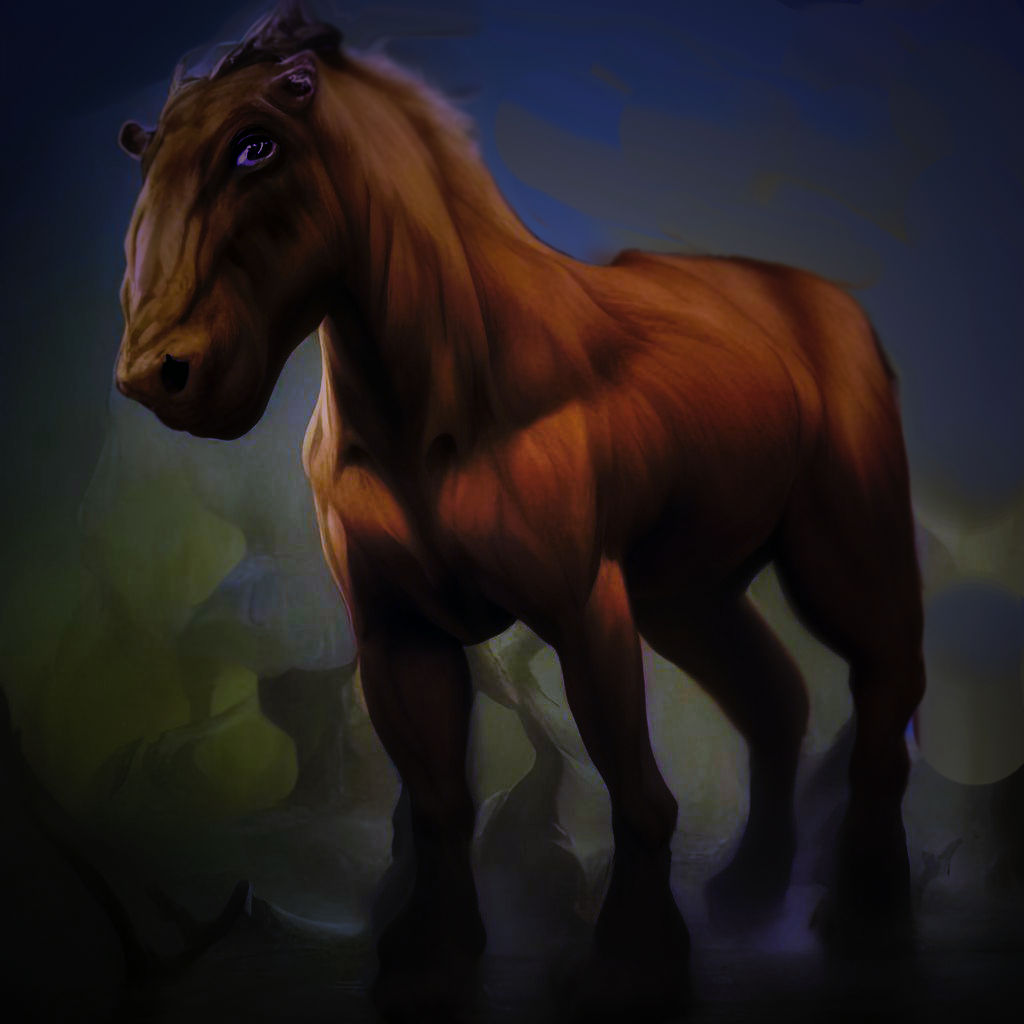Hegyembi Mule
Hegyembi Mules are short, stout equine creatures who have evolved to spend much of their lives in caves and caverns, only venturing out at night to eat. Unsurprisingly, Hegyem miners have domesticated the beasts to act as draft animals, which is where they get their name.


Hegyembi Horse by Steve Johnson
Basic Information
Anatomy
Hegyembi Mules are small, heavily-muscled horse-like creatures with thick necks and heads that slightly resemble a cow or moose. They have some semblance of manes and tails, but both are short and coarse compared to those of other equines. All four of the Hegyembi Mule's legs are double-jointed, which is useful for scurrying through tight spaces, but can cause concern to humans who aren't used to seeing equines standing (or worse, moving) with their legs bent "backwards."
Genetics and Reproduction
Hegyembi Mules are solitary creatures, only encountered in pairs when mating or when a mare (djenni) is still caring for a foal (losha). Males (ishaks) will attempt to breed with any mare they encounter who isn't pregnant or caring for a foal, but only about 50% of these pairings result in offspring. The gestation period ranges from 11 to 15 months, and produces one foal. While twins are not unheard of, they are so rare that the Hegyems consider them a sign of good fortune (assuming both survive the birth; a pair of stillborn twin mules is considered a very bad omen). Domesticated djennis who are being actively bred typically only give birth about once every 3 years.
Growth Rate & Stages
Like horses, Hegyembi mules are capable of standing and running practically as soon as they're born. Foals are weened after about nine months and separate from their mother shortly thereafter. They reach full size at about two years old, but generally don't begin breeding until age 3 or 4. Wild Hegymbie mules rarely live over 20 years, but domesticated animals typically live to 25 or 30, with a few living close to 40 years.
Ecology and Habitats
Hegyembi Mules nest in caves and caverns, venturing out at night to eat grass and other plants. When the outside world is unpleasant or dangerous due to bad weather or predators roaming the area, they can usually survive on fungi and other underground food sources.
Dietary Needs and Habits
Hegyembi Mules subsist mainly on grass. leaves, and other plant life, but as previously mentioned they have a knack for finding fungi, lichen, and other edibles. They can also eat carrion when necessary, and will even attempt to kill insects and small mammals when no other food is available. Their teeth are not particularly suited for tearing meat, but their saliva contains enzymes that can dissolve meat over time. They simply hold their prey or an appropriately-sized chunk of carrion in their mouth and swallow little bits as they liquify. It's just as disgusting as it sounds.
Biological Cycle
When food is sparse, Hegyembi Mules tend to hibernate, often sleeping for several days at a time to conserve energy. They usually eat voraciously in fall, then seek out the deepest caves they can find so they can spend the winter out of reach of the elements. Domesticated mules who are kept fed continue to function normally, but will balk at getting too close to mine entrances where the wind and snow can get to them.
Behaviour
As long as they are cared for and fed, domesticated Hegyembi Mules are docile and hard working. However, they do not like extreme conditions and will often refuse to go outside in strong winds or heavy rains or to enter sections of the mines that are extremely hot or cold. Mules who are routinely underfed or mistreated will run away if they can and will eventually become aggressive if they can't.
Additional Information
Domestication
The Hegyem use their mules to pull carts full of ore and debris and power lift platforms and other mining machinery. When miners get lost, cut off by a cave-in, or otherwise stuck underground, they often turn a mule loose in hopes that it will lead them to food and water or a route out of the mines.
Geographic Origin and Distribution
Hegyembi Mules are found in temperate areas near mountains or hills with plentiful natural cave systems.
Average Intelligence
Hegyembi Mules are no more or less intelligent than other equines.
Perception and Sensory Capabilities
Although the Mules who have been domesticated for mine work have adapted to a daytime schedule, the creatures are naturally nocturnal and spend a lot of time underground, which has given them excellent vision in darkened conditions. They also have a highly developed sense of smell that is particularly attuned to sniffing out potable water and edible fungi, as well as avoiding Spite Bats and other dangerous creatures.
Symbiotic and Parasitic organisms
Domesticated Hegyembi Mules are accustomed to working in close proximity with Sin-Eater Goats, who often serve as a sort of sheep dog for the mules in a work crew.
Lifespan
20 years in the wild, 25+ in captivity
Average Height
4' at shoulders
Average Weight
800 pounds
Average Length
4.5'
Average Physique
Despite their small size, Hegyembi Mules have powerful muscles and are capable of carrying or pulling heavy loads as well as a draft horse nearly twice their size.
Body Tint, Colouring and Marking
Hegyembi Mules exhibit the same range of colors and markings as horses and mules, but tend toward darker colors. Albinism occurs, but is rare enough that the Hegyem believe albio mules to be semi-magical creatures gifted with the power of prophecy. As such, albinos born in captivity are extremely well-treated and never put to work.
Geographic Distribution
Related Ethnicities





Comments